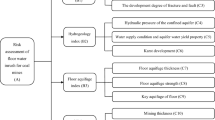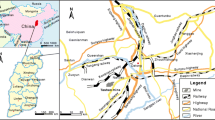Abstract
A risk evaluation method based on principal component analysis, fuzzy mathematics, particle swarm optimization, and support vector classification, is proposed due to the limitations of the water inrush coefficient method. The many factors that influence coal floor water inrush were categorized as structural, hydrogeological, coal seam occurrence and mining condition principal components, according to principal component analysis, among which the structural and mining condition components were the most important. The principal component factors were then fuzzified. Finally, an evaluation method was established, with the parameters of the supporting vector classification optimized through the particle swarm algorithm. The validity of the method was demonstrated by comparing its predictions with actual conditions at ten coal seam mining faces.
摘要
由于突水系数法的局限性,本文基于主成分分析、模糊数学、粒子群优化优化算法、支持向量分类等方法提出了一种非线性底板突水评价方法。根据主成分分析法将影响煤层底板突水多种因素分为构造主成分、水文地质主成分、煤层赋存规律主成分、采动条件主成分,其中构造和采动条件是最主要组成成分。然后,将主成分影响因子进行模糊化。最后,通过粒子群算法优化支持向量机参数,建立底板突水评价方法。利用该评价方法对10个工作面进行底板突水预测,并与实际情况进行比较,证明了该方法的有效性。
Zusammenfassung
Eine Methode zur Risikoabschätzung, basierend auf Hauptkomponentenanalysen, mathematischen Fuzzy-Logik-Verfahren, Partikel-Schwarm-Optimierungen und Stützvektorverfahren, wird vorgestellt, um der eingeschränkten Nutzbarkeit von Koeffizienten-Verfahren bei Wassereinbrüchen zu begegnen. Die unterschiedlichen Faktoren, welche Wassereinbrüche aus im Liegenden verbreiteten Kohleflözen beeinflussen, werden hinsichtlich ihrer strukturellen, hydrogeologischen und ihrer bergbaulichen Eigenschaften sowie der Köhleflözverbreitung mit Hilfe einer Hauptkomponentenanalyse kategorisiert. Hierbei haben die strukturellen und die bergbaulichen Eigenschaften den wichtigsten Einfluss. Eine Hauptkomponentenanalyse wird danach mit Hilfe von Fuzzy-Logik-Methoden durchgeführt. Im Anschluss wird eine Risikoabschätzung etabliert, wobei Parametern aus Stützvektorverfahren, optimiert durch Partikel-Schwarm-Algorithmen, genutzt werden. Das Verfahren wird durch einen Vergleich der Vorhersagen mit rezenten Bedingungen an fünf Kohleabbauen validiert.
Resumen
Debido a las limitaciones del método del coeficiente de irrupción de agua, se propuso un método de evaluación de riesgo basado en el análisis de componentes principales, matemáticas difusas, optimización por nube de partículas y clasificación de vectores de soporte. Los factores que influyen sobre la irrupción de agua a través del piso fueron categorizados como estructurales, hidrogeológicas, ocurrencia de las vetas de carbón y componentes principales de la condición minera, de acuerdo al análisis de componentes principales; se encontraron que el factor estructural y la condición de los componentes minero fueron los más relevantes. Se aplicó matemáticas difusa sobre los componentes principales. Finalmente, se estableció un método de evaluación con los parámetros de la clasificación del vector soporte optimizado a través del algoritmo de la nube de partículas. La validez del método fue demostrado por comparación de sus predicciones con las condiciones actuales de 10 caras de trabajo sobre vetas de carbón.



Similar content being viewed by others
References
Cao QK, Zhao F (2011) Risk evaluation of water inrush from coal floor based on fuzzy-support vector machine. J China Coal Soc 36(4):635–637 (in Chinese)
Gao YF, Zhang YP, Zhang HM, Wang SG (2009) Research on expert system for risk assessment of water inrush from coal and its application. Chin J Rock Mech Eng 28(2):253–258 (in Chinese)
Jia JP (2008) Statistics. 3rd edn. Chinese Renmin Univy Press, Beijing (in Chinese)
Jin DW, Ma ZP, Wang YF (1998) Random-information simulation and forecast of water inrush through coal seam floor in mining areas of northern China. Coal Geol Explor 26:36–39 (in Chinese)
Li Y (2007) Prediction method study on water inrush through coal floor base on support vector machines. MSc thesis, Coal research institute of Xi’an branch, Xian City, China (in Chinese)
Liu BZ, Liang B (2011) Prediction of seam floor water inrush based on combining principal component analysis and support vector regression. Coal Geol Explor 39(1):29–35 (in Chinese)
Liu ZB, Jin DW, Liu QS (2009) Prediction of water inrush through coal floor based on binary logistic regression model and CART. Coal Geol Explor 7(1):56–61 (in Chinese)
Qiao W, Li WP, Zhao CX (2009) Water inrush coefficient unit-inflow method for water inrush of coal mine floor. Chin J Rock Mech Eng 28(12):2466–2474 (in Chinese)
Shi LQ (2012) Analysis of the origin of water inrush coefficient and its applicability. J Shandong Univ Sci Technol 31(6):6–9 (in Chinese)
Shi LQ, Han J (2004) Floor water inrush mechanism and prediction. China University of Mining and Technology Press, Xuzhou (in Chinese)
Shi XW, Hu YQ, Zhang HS (2008) GIS-based forecasting model of floor water bursting in coal mines. J Taiyuan Univ Technol 39(5):244–246 (in Chinese)
Shi LQ, Wei JC, Liu TB, Zhu L, Zhai PH, Han J (2012) Detection technology of hydrogeological condition in deep mine and dynamic monitoring floor water. Coal Industry Press, Beijing (in Chinese)
Shi LQ, Xu DJ, Qiu M, Jing X, Sun HH (2013) Improved on the formula about the depth of damaged floor in working area. J China Coal Soc 38(2):299–303 (in Chinese)
Tao WW, Zhao BT (2013) Prediction of gas liquid mass transfer efficiency of CO2 absorption by rotating packed bed based on least squares support vector machine. J Chin Coal Soc 38(12):2253–2258 (in Chinese)
Vapnik V (1995) The nature of statistical learning theory. Springer, New York
Wang JY, Li CP, Li ZX (2013) Risk prediction of water in-rush from coal floor based on principal component clustering analysis. Chin Safe Sci J 23(8):120–125 (in Chinese)
Wu Q, Li B, Liu SQ, Zeng YF (2013a) Vulnerability assessment of coal floor groundwater bursting based on zoning variable weight model: a case study in the typical mining region of Kailuan. J Chin Coal Soc 38(9):1516–1521 (in Chinese)
Wu Q, Fan SK, Zhou WF (2013b) Application of the analytic hierarchy to assessment of water inrush: a case study for the No. 17 coal seam in the Sanhejian coal mine, China. Mine Water Environ 32(3):229–238
Wu Q, Liu Y, Zhou WF (2015) Evaluation of water inrush vulnerability from aquifers overlying coal seams in the Menkeqing coal mine, China. Mine Water Environ 34(3):258–269
Yu XG (2008) Forecast of floor water bursting based on information fusion. MSc thesis, Shandong Univ Science and Technology, Qingdao City, China (in Chinese)
Yu XG (2011) Study on broken depth of damage floor. PhD thesis, Shandong Univ Science and Technology, Qingdao City, China (in Chinese)
Zhang WQ, Zhang GP, Li Wei, Hua X (2013) A model of Fisher’s discriminant analysis for evaluating water inrush risk from coal seam floor. Chin Coal Soc 38(10):1832–1836
Acknowledgements
This work was supported by the National Science Foundation (41572244), the Shandong Province Nature Science Fund (ZR2015DM013), the Shandong University of Science and Technology graduate innovation fund for science and technology (SDKDYC170212), and the Taishan Scholars construction projects fund. The authors gratefully acknowledge the anonymous reviewers who substantially improved the manuscript.
Author information
Authors and Affiliations
Corresponding author
Rights and permissions
About this article
Cite this article
Shi, L., Gao, W., Han, J. et al. A Nonlinear Risk Evaluation Method for Water Inrush Through the Seam Floor. Mine Water Environ 36, 597–605 (2017). https://doi.org/10.1007/s10230-017-0449-1
Received:
Accepted:
Published:
Issue Date:
DOI: https://doi.org/10.1007/s10230-017-0449-1




